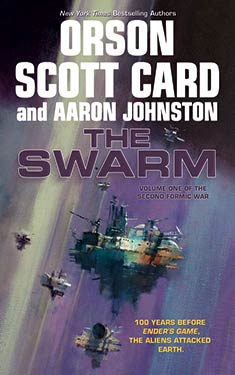
Added By: valashain
Last Updated: Engelbrecht
The Swarm
| Author: | Orson Scott Card Aaron Johnston |
| Publisher: |
Tor, 2016 |
| Series: | Ender's Universe: Second Formic War: Book 1 |
|
1. The Swarm |
|
| Book Type: | Novel |
| Genre: | Science-Fiction |
| Sub-Genre Tags: | Alien Invasion Hard SF Military SF |
| Awards: | |
| Lists: | |
| Links: |
|
| Avg Member Rating: |
|
|
|
|
Synopsis
Orson Scott Card and Aaron Johnston return to their Ender's Game prequel series with this first volume of an all-new trilogy about the Second Formic War in The Swarm.
The first invasion of Earth was beaten back by a coalition of corporate and international military forces, and the Chinese army. China has been devastated by the Formic's initial efforts to eradicate Earth life forms and prepare the ground for their own settlement. The Scouring of China struck fear into the other nations of the planet; that fear blossomed into drastic action when scientists determined that the single ship that wreaked such damage was merely a scout ship.
There is a mothership out beyond the Solar System's Kuiper Belt, and it's heading into the system, unstoppable by any weapons that Earth can muster.
Earth has been reorganized for defense. There is now a Hegemon, a planetary official responsible for keeping all the formerly warring nations in line. There's a Polemarch, responsible for organizing all the military forces of the planet into the new International Fleet. But there is an enemy within, an enemy as old as human warfare: ambition and politics. Greed and self-interest. Will Bingwen, Mazer Rackam, Victor Delgado and Lem Juke be able to divert those very human enemies in time to create a weapon that can effectively defend humanity in the inexorable Second Formic War?
Excerpt
CHAPTER 1
Copernicus
The First Formic War was a close-fought thing. The Formic invaders had the capacity to destroy all life that was based on our particular array of amino acids, which, being indigestible to them, was not worth preserving. The Hive Queen did not view her actions as an attack, but rather as a leisurely beginning to the formification of Earth.
We eked out our victory against an enemy whose commander--whose mind--was millions of kilometers away. Later we would learn that the Hive Queen commanded her workers through philotic connections that seemed not to attenuate or slow down with distance; signals from the human brain take longer to reach our fingers than it took the Hive Queen to receive sensory information from her workers, learn that the pesky native life-form was resisting the advance ship's ministrations, and repurpose those workers as soldiers.
Then the humans blew out the interior of the advance ship and killed every last one of her workers. Not only would she arrive at this new planet without the native biota already having been replaced by compatible life-forms, but she would also be forced to approach it with an effective military strategy. She immediately conferred with her sisters on all the other populated planets, showing them how the humans had behaved, the structure of their bodies, the weapons they had used.
Colonization of new worlds always brought challenges that required improvisation, but now for the first time a Formic colony was encountering friction that was intelligent, organized, and effective. However, if there was one thing the Hive Queens were experts at, it was war.
She had come in search of a place to spawn another iteration of the Formic civilization, a peaceful, domestic mission, or so she supposed. Now, she and her sisters could reach back into their not-so-very-ancient memory of brutal wars between Hive Queens, which had spawned a sophisticated military technology.
With the approval of her sisters, she dismantled almost the entire apparatus of colonization and converted the materials of the vast mothership into the requisite number of invasion craft. She had intended to wield only her delicate, sacred ovipositor, but finding the way blocked, she drew her sword.
--Demosthenes, A History of the Formic Wars, Vol. 3
Mazer Rackham drifted away from the space station, sealed inside a capsule no bigger than a coffin, his weapons and gear pressed tight against him. The capsule tumbled end over end, spinning in three dimensions through zero gravity. Mazer's equilibrium was gone in an instant. Up and down no longer had meaning. All he could do now was close his eyes, concentrate, and try to find the pattern in his rotations.
The speed and spin of the capsule changed with every test flight, and so Mazer never knew how fast or in what manner the capsule was going to rotate until the sling mechanism inside the space station's launch bay had tossed him out into the blackness of space.
This spin wasn't bad, he realized. He had done plenty of test flights far worse than this one, with the rotations so fast and uneven that it was all he could do to keep from vomiting. This, by comparison, was a Sunday stroll. A lazy spin, at a negligible speed. Like a discarded piece of space debris casually drifting through the Black--which of course was the intent.
The capsule was a tactical trick. A work of camouflage made to resemble a twisted hunk of ship debris, charred and jagged at the edges as if it had been torn from a ship in a violent explosion. A whole team of artists from the International Fleet had worked on its design for weeks, meticulously painting and bending every square inch of the metal exterior until it looked like space junk. Barely worth anyone's notice except as a possible collision threat. The Formics would see it, dismiss it as harmless, and the marine concealed inside could float right up to the Formic ship and cut his way inside.
A nice idea. But Mazer had his doubts. Doubts he had expressed in every test-flight report. Whether anyone actually read the reports and paid him any attention he couldn't tell.
He cleared his mind and focused on the task at hand: finding the pattern in the capsule's spin.
Mazer let his body go limp, feeling the centripetal forces pulling at him from multiple directions.
The spin was a sequence repeating itself again and again. An object in motion remained in motion. If Mazer could identify that sequence, if he could anticipate how the capsule would spin next, he could prepare himself properly to exit the capsule when he reached his target.
Our brains weren't programmed for this, he thought. A lifetime of living in a gravitational environment has trained us to process trajectories completely differently.
He wondered if he would ever get used to zero G. Even after years of training in space he still felt like an awkward novice, not because his movements were clumsy but because he was nowhere near as agile out here as he had once been on Earth.
If I had started out here as a child, he thought, or if I had begun training as a tween, this would all be second nature by now.
He envied the free-miner recruits for this very reason. Most of them were born in space on asteroid-mining vessels throughout the Kuiper or Asteroid belts. Zero G was their home. Flight came easily. Spinning, launching, mapping a trajectory. They didn't have to think about it; they just moved.
Of course the bureaucracy at the IF kept free miners from reaching any legitimate position of influence within the Fleet. Those positions were held by experienced soldiers from Earth, the career officers who had clawed their way to the top and weren't about to let blue-collar rock diggers give them any orders. That left free miners with the remedial jobs within the Fleet: mechanics, load operators, shipbuilders, cooks. Critical entities, to be sure. But why not train them for combat? They had more experience with the environment. Teaching them to handle a weapon seemed easier than teaching Earth-grown soldiers to think in zero G.
Or why not pair free miners with soldiers? Mazer had made the suggestion to a dozen different commanders. Have the free miner teach the marine how to fly and have the marine teach the free miner the essentials of combat. Unify the cultures. Share information and expertise. Break down the barriers and integrate the personnel to produce soldiers more capable in every way.
Oh, how Mazer's commanding officers had laughed at that. Silly, silly Mazer. Don't you get it? Don't you understand your place? There are soldiers and there are worker bees, and the uneducated rock diggers will always be the bees.
Free miners saved us, Mazer had countered. If not for their help we would've lost the war.
But he had quickly learned that saying so only invited isolation and dismissal. Do your job, Mazer, they said. Either you're one of us or you're one of them. If you're one of us, you won't keep trying to drag outsiders into IF command.
Nobody seemed to care that Mazer had actually fought the Formic invaders, on Earth and in space. All that mattered was his official record--in which his elite training was pretty much trumped by charges of insubordination. The elite training was from New Zealand, after all--not one of the great powers, so treating him well wouldn't give the bureaucrat any career advantage.
And there was no point in explaining that his "insubordination" consisted of him fighting the Formics in China when every other nation was obeying China's demand that they stay out. That insubordination had led to the nuclear destruction of one of the Formics' earthside bases and then later to the gutting of the Formic mothership. But none of that was in his file.
No, not a mothership, Mazer reminded himself. A scout ship. We thought we were facing an invasion army, but the Formics that landed on Earth were merely the advance party, the terraformers, the workers sent ahead to prepare Earth soil for Formic vegetation. Farmers, basically. And the gases they had sprayed across southeast China that had killed forty million people were not military weapons, but terraforming tools. Weed killer. They were simply clearing the land and running off the rodents so that new occupants could move in.
Mazer had helped put an end to it, but since the operation had been deemed classified, his file made no mention of his involvement. And his commanding officers went by what was in his file.
It didn't help that the International Fleet was hopelessly broken. Infighting, bureaucracy, dogmatic command, rivalries, conflicting agendas, careerists. In the three years since joining up, Mazer had seen it all.
He had known this would happen. You couldn't combine the militaries of the world into a single army and suddenly expect everyone to play nice. Rivalries would persist. Cultures would clash. Centuries of mistrust between enemies would linger. Plus there was the added challenge of coming to a unified consensus on discipline, structure, hierarchy, process--the most basic models of operation. And since no two militaries were alike, and since everyone dismissed every other nation's military philosophies as misguided, watching the IF try to function as a single organization was like tossing a slab of meat to wolves.
Still, Mazer had remained patient. No, optimistic, believing that the threat to the human race would eventually take precedence over all other considerations. Yet now, stationed at an IF outpost at L4--gravitationally balanced between Earth and Luna--Mazer's hope in the IF was fading.
He didn't let them stop him, however. He had his missions and he would fulfill them. The International Fleet might rot from the inside out, but Mazer would do his duty as best as he knew how.
After several minutes of concentration, he finally found the pattern in the capsule's spin.
Mazer blinked a command to initiate the gyroscope to see if he was right. A holographic model of the capsule appeared on his heads-up display--HUD--inside his helmet. He had been correct. There was the pattern of his spin. A constant through space, giving order to a seemingly random tumble.
He blinked a second command and the holo disappeared, replaced with an image of his target: an old derelict supply ship directly ahead of him. The ship had been pulled from a scrapyard somewhere and painted and modified to resemble a miniaturized version of the Formic scout ship.
A familiar voice sounded over the radio. "Four hundred meters to target."
It was Rimas, one of the three marines in Mazer's breach team. They were each inside their own capsule tumbling through space behind Mazer, heading toward the same derelict ship.
The tactic had worked once in the last war, but the capsules in that instance had approached their target from multiple angles. The IF wouldn't always have that luxury in combat, so the IF had devised these smaller capsules with advanced avionics. Could a team of four marines approach a target from the same direction and carry out a complex, coordinated strike without colliding with one another or raising alarms?
"Three hundred meters," said Rimas. "Get ready, my fellow guinea pigs. Prepare for exit and launch."
Shambhani spoke next. He was the youngest of the bunch. A Pakistani from Karachi. "We're not guinea pigs, Rimas. We're lab rats. Running through mazes. Pushing buttons. Getting shocks. But no prize at the end."
Kaufman, the fourth member of the team and a former commando in GSG9, the special ops unit of the German Federal Police, laughed over the radio. "We can't be lab rats, Shambhani. No rat would be stupid enough to crawl inside these cans."
Mazer smiled. Lab rats. It was a fair comparison. As marines in the International Fleet's Weapons and Materials Research Division--WAMRED--it was Mazer and his team's responsibility to test the latest experimental tech being considered for combat. Everything from biometric-enabled socks to shielded landing crafts. Some of it worked. Some of it didn't. Some of it was so stupid in its design that it was more likely to get a marine killed than save him from the enemy. The stupid designs were easy to dismiss, but tech like the capsules was harder to evaluate. Could they work? Yes. Would they work? Probably not. And it was in this gray area of ambiguity where the bureaucrats and defense contractors did their worst, with everyone fighting to protect their own proposed tech and projects. It meant a lot of bad tech was getting the rubber stamp of approval, and there was little Mazer could do about it.
"Two hundred meters," said Rimas. "Here we go, Captain. The radio is yours."
"All right, gentlemen," said Mazer. "Now that we're all dizzy and discombobulated, let's get to work. Know your rotation. Exit smart. If you miss the target, you'll drift off into oblivion and be no help to any of us. We land, we set the charges, and we clear the area. Rimas you have point."
"Yes, sir."
They had practiced the maneuver dozens of times, but they knew better than to treat this as routine. They would go in as if their lives depended on it because one day that might be the case. Precise movements, complete coordination. Anything less was failure.
A chime sounded in Mazer's earpiece. A proximity warning. "Approaching the drop," he said. "Here we go."
When his capsule got to its nearest approach to the ship's surface, Mazer opened the door, pulled himself out of the cockpit, and fired propulsion from the back of his spacesuit, pushing himself, untethered, toward the target ship.
The maneuver would be impossible if he didn't first understand how the capsule was spinning. And even then it was incredibly difficult to pull off, not only because of the capsule's rotations but also because the capsule was approaching the target not on a direct course, but at a diagonal vector that merely passed by the ship at a safe but short distance. A collision course would alert the Formics' collision-avoidance system; they would fire on the capsule to protect their hull. But a nonthreatening flyby would likely go ignored. The trick was getting close enough to make the leap and yet staying far enough away so as not to draw attention. All without altering the original course of the capsule--for any sudden shift in trajectory might raise Formic alarms.
Mazer tapped his propulsion twice more, then brought up his feet and landed on the hull. The soles of his boots were made of Nan-Ooze, a thick gel composed of thousands of nanobots that attached to every scratch or irregularity on the surface of the ship. Mazer ordered the Nan-Ooze to go rigid, and it solidified inside the scratches, locking his feet in place and anchoring him to the ship.
He drew his slaser--short for self-aiming laser--and advanced toward the breach site, walking as quickly as his goo boots allowed. He scanned right and left along the surface of the ship, keeping an eye out for any computer-generated Formics that might appear on his HUD.
Ahead of him, Rimas landed on the breach site, a large circle on the side of the ship. Rimas then knelt in the center of the circle and anchored the guidebox to the hull. The guidebox emitted four low-powered lasers, pointing north, south, east, and west, indicating where along the edge of the circle Mazer and his team should place the four cubes of the breach weapon.
Gungsu Industries, the Korean contractors who had built the weapon, called it a gravity disruptor--GD. It used four tidal forces to tear an opening in the ship large enough for the marines to crawl through. It did so with four separate cubes placed on the surface of the ship in a square pattern. The four corners of the square created four overlapping triangles that could tear apart any surface. Yet to work, the cubes had to be placed exactly right, meaning far enough apart that the curvature of the hull would put the surface in the straight lines between them. Placed wrong, the cubes could create shrapnel clouds or fail to tear a large enough hole.
Rimas left the guidebox in place and went to one of the four points where a cube should be set. He pulled his cube from his pouch, twisted it to activate it, and set it Nan-Ooze side down. "Rimas here. The baby is delivered."
"Roger that," said Mazer. "We're right behind you."
Mazer and the others reached the circle as Rimas stood up and drew his slaser, covering them.
Mazer moved to his assigned position and removed his own cube from his pouch. He twisted the mechanism to activate it, noting once again that the action felt far too cumbersome with his bulky gloved fingers.
There's too much assembly here, he thought. Too many possibilities for human error. We need to simplify this before we move to live tests. He made a mental note to inform the engineers.
"We've got bugs," said Rimas.
Mazer lifted his head and saw, projected on his HUD, five virtual Formics in spacesuits scuttling on all six appendages across the surface of the ship toward them, each of them armed with a glowing jar weapon and moving fast. The augmented reality simulation melded so well with the real environment that Mazer instinctively reached for his weapon. Then he calmed and focused his attention back on his cube, leaving the Formics to Rimas, his point man.
Rimas took out four Formics with four quick shots, and the creatures exploded into pixels before disappearing from everyone's HUD.
"Cube Two is set," said Kaufman. Then he was up on one knee, aiming his slaser and picking off Formics with deadly accuracy. For every two Formics vaporized, four more appeared in their place, closing in from multiple sides and firing their jar guns as they came.
Shambhani swore.
Mazer turned and saw that an image of a doily was now projected onto Shambhani's chest along with the words KILLED IN ACTION. "You're hit, Sham," said Mazer. "You're out."
Doilies were small, flat, bioluminescent organisms fired from the Formic jar guns. In any other circumstance they would be beautiful to look upon. Weblike in structure, they resembled a magnified snowflake, with its many symmetrical crystals and stellar dendrites--or an intricately crocheted doily lying atop an antique piece of furniture. Here, however, encircled about in a clear gel as thick and sticky as tar, doilies were weapons of death. The gel acted as an adhesive when the doily struck its target. Then, upon impact, the doily released a peroxide polymer that reacted violently with the adhesive gel. The polymer was a natural injury response, chemicals released to cope with internal bruising. Formics had obviously engineered the doilies to overexpress the polymer, in much the same way that bacteria are tricked into overexpressing proteins. The result was a contained and highly directional explosion, tearing apart the human's spacesuit and all the bone, skin, muscle, and organs inside it. Mazer had seen it happen, and they were memories best forgotten.
"I can finish it," said Sham. "I'm almost done." He was still trying to open and set his cube.
"You're dead," said Mazer. "Stop. Nothing you do from now on will count in our results. Leave it for me."
Mazer locked down his own cube. "Cube Three is set." Then he launched himself at Sham, whose boot tips and knees were still anchored to the hull. Mazer collided with him, grabbing Sham around the upper body to keep himself from ricocheting off into space. Then Mazer swung his legs down, took Sham's cube, gave it a final twist to activate it, and anchored it to the hull.
"Cube Four is set," Mazer said. "Clear the square." He moved a safe distance away from the square and said, "Launch!"
He winked a command, and the Nan-Ooze sole of his boots released their grip on the surface save for a small square of Nan-Ooze in the center of his foot. Mazer leaped upward away from the ship, with the Nan-Ooze forming into a long thin polymer line, growing thinner and thinner as it extended, tethering him to the small square of Nan-Ooze still rooted to the ship.
Mazer was firing the whole time. He took out three virtual Formics. Then a fourth. Rimas and Kaufman fired also, soaring up beside him. Then Kaufman was hit, and his Nan-Ooze ceased extending.
Mazer soared another ten meters. Then his skinnywire snapped taut, stopping his ascent thirty meters above the ship.
"Fire," he said.
Had the gravity disruptor been live, and not merely practice cubes, the cubes would have unleashed their tidal forces and ripped a hole in the hull, throwing the torn debris inward.
Mazer and Rimas took out the last few virtual Formics, and then all was still.
Mazer shut down his slaser and said, "Reel in." The Nan-Ooze pulled him downward, the polymer nanotech line getting thicker and thicker until it formed back into the sole of his boot when he reached the surface.
At that point, the exercise was over.
Mazer got on the radio with the space station and called for an extraction. Then he turned to see that his teammates were all deep in thought, heads down, mentally retracing their steps. He had trained them to do this, to dedicate the time immediately following an operation to silently consider what they had just done. Where were they weak? What had they failed to consider? How could they improve?
They remained in silence for the duration of the flight back to WAMRED. It wasn't until they had changed out of their gear and gathered in the debriefing room, feet anchored to the floor, that Mazer spoke again. He started his recording device to ensure that he captured everything they discussed. "Mission succeeded but we lost two men," he said. "Fifty percent wastage. Not acceptable. Thoughts?"
Rimas spoke first. "We had a whole Formic army coming at us from every side. We weren't ready for that."
"There were a lot," Mazer agreed. "But that might be exactly the battle conditions marines face."
"It wasn't just the numbers," said Rimas. "They were all staying really close to the hull this time. Combat-crawling. That made it hard to get a bead on them without standing up and further exposing myself. If I had had better cover from a standing position, I could've inflicted a lot more damage instead of worrying about getting shot."
"There is no cover," said Shambhani. "There's nothing on the surface of the ship we could have used."
"What if marines were to bring cover with them?" said Rimas.
"How?" Kaufman asked. "In the capsules? There's no room for anything else. And if you make the cockpit any bigger to accommodate more cargo, you risk drawing unwanted attention to the thing. It starts looking less like debris and more like a ship."
"What about shields?" asked Sham. "Like riot police carry. We could use them as covers for the cockpits. That way, the shield wouldn't take up any more room inside the capsule."
"No riot shield is going to stop a doily," said Kaufman.
"Not a traditional riot shield," Sham said. "It wouldn't be made of fiberglass. You'd need something sturdier. Steel maybe."
Kaufman shook his head. "Wouldn't work. Your feet are locked to the surface by Nan-Ooze. The force of the blast would slam you back against the hull of the ship. Your legs would break. Think ugly, compound fractures."
"That's easy to fix," said Rimas. "We program the Nan-Ooze to release all but one heel or all but one toe of the boot."
"Fair enough," said Kaufman, "but you're still going to get your ass slammed against the ship like a rag doll. You might not break your legs, but you're bound to break something. And anyway there are other problems. Steel would add a lot of mass. It would be hard to maneuver. Plus it would occupy one of your hands. Now you're one-handed."
"Beats getting a doily to the chest," said Sham.
"What if the front of the shield were covered in a layer of Nan-Ooze?" Mazer said. "It could surround and smother the doily on impact, before it exploded."
"I've never seen Nan-Ooze move that fast," said Rimas. "The doily would detonate before the Nan-Ooze surrounded it."
"Maybe the Nan-Ooze doesn't have to move at all," said Mazer. "It's nanotech in a weightless environment. We can make it as thick as necessary, say, fifteen centimeters to give the projectile a deep enough surface to embed itself. And we control the consistency of the Nan-Ooze as well, soft enough so that the doily punches into it and yet not so soft that the Nan-Ooze splatters."
"Like lard," said Rimas.
"The doily gets completely submerged before it detonates," said Mazer. "It would dampen the explosion, take the brunt of the blast. It might even be enough to keep you on your feet."
"And even if the Nan-Ooze disperses violently," said Sham, "it can self-propel and return to the shield."
"I still can't shake the problem that now I'm one-handed," said Kaufman. "I've got this unwieldy thing strapped to me, impeding my movements."
Mazer shrugged. "So maybe the Nan-Ooze doesn't cover a shield. Or maybe it's not even Nan-Ooze. But the idea of nanotech remains. So we get a semipermeable cloud of nanobots that loosely form a shield. Marines can see through it like thin haze. But as a doily approaches, the haze forms into a shield to enfold the doily and encase it, to make it nothing but a harmless thud against their bodies."
"So the shield's not strapped to me?" Kaufman asked.
"No," said Mazer. "It's a hovering cloud of nanobots. They only have to be flight-capable in zero atmosphere and zero G. They could hold themselves in place relative to each other by magnetics."
He flipped on the holotable, and began drawing up what he had in mind. It was a crude sketch--Mazer was no artist--but his team understood the basic design. They discussed it for several hours, tweaking the design as they went along until they had a concept that felt practical and addressed all their concerns. By then Shambhani had replaced Mazer's original sketch with a detailed model.
"You know, this actually might work," said Shambhani.
"I have no idea how to build it," said Rimas. "I'm no nano-engineer. But the idea seems solid. If nothing else, it gives the development guys a starting place. This could save a lot of lives."
"Agreed," said Mazer. "Good work. I'll post the design on the forum and see what everyone thinks."
The forum was an online community Mazer had created on the IF's intranet. Junior officers from all over the solar system gathered there to share tactics, tech ideas, and new intel on the enemy, including academic papers and whatever the scientific community was publishing about the Formics.
When the forum launched two years ago, Mazer had assumed he would get a few dozen participants at most. Now the site had over two thousand daily users.
Mazer waited until he was in the barracks that night and zipped up in his sleep sack before logging in to the forum with his tablet. He browsed for a few minutes, checking the sub forums for any new posts. A researcher out of Caltech was studying a small organelle harvested from one of the Formic cadavers. A Chinese chemical company was developing genetically altered rice seed that was supposedly resistant to Formic bioweapons. A lieutenant overseeing a team of laserline operators at a relay station near Jupiter had tweaked their transmitter's operating system and increased transmission speeds by 14 percent. His post included instructions on how others could do the same.
Mazer skimmed through these posts and others, soaking up whatever he thought significant. He read through some of the comments and was pleased to see that they were polite and well-considered. New insight was shared, feedback was given, modifications were proposed.
It baffled Mazer that most senior commanders didn't think this way. They hated sharing intel. The idea of a forum would make their eyes twitch. Intel was something to keep hidden and use only for personal gain.
Mazer didn't understand it, and he knew it was a waste of time to even try. Nothing he did would ever change their thinking. All he could do was share his own.
He generated a new post and uploaded the model of the nanoshield, describing it in detail and inviting criticism. Is this feasible? Worth pursuing? What are the possible drawbacks, defects, dangers, consequences? Then he published the post, signed off, and waited for feedback.
His inbox was next. He smiled when he saw the e-mail from Kim. Were all wives this faithful in their correspondence, he wondered. Kim wrote every day, no exceptions. Even when she was working double shifts at Imbrium Memorial on Luna, she still found time between patients to tap out a quick message.
The hospital was being inundated with refugees, her e-mail said. A virus was spreading through the camps. Nothing life-threatening, but the hospital was keeping infants and the elderly and the worst cases for observation. Beds were scarce. Mazer could almost hear the frustration in Kim's words.
The refugees were mostly free miners from the Belt who had sold their ships to the IF to support the war effort and escape the trade. The miners had used the funds to reach Luna and now had nowhere to go. Few had enough money to carry their families to Earth, and even those who could afford passage were now uncertain if they wanted a life in Earth's gravity. Decades in zero G had left some of them so weak-boned and unambulatory that life on Earth would mean confinement to a wheelchair.
"The news reports don't do these people justice," wrote Kim. "They're afraid. The adults as much as the children. The war ended three years ago, but for them it's an ongoing fight. If I spoke Farsi and Vietnamese and all the languages of sub-Saharan Africa, I could maybe comfort some of them and put their minds at ease. But for many, I can only smile and give their hands a squeeze. It would break your heart to see some of these parents clinging to their sick children."
She ended the way she always did: "Tell me you're safe. Remember I love you. Believe we can win."
Mazer read the e-mail again. She was there in the words. Everything he loved about her was on display. And yet it pained him to read it because she was a world away, living a life he was no longer a part of.
He closed his inbox and opened the vid he kept on his desktop. The sound was muted, but Mazer had watched the vid so many times, he could practically hear every word. Onscreen Kim waved at the camera from the kitchen of their apartment on Luna as she chopped vegetables for a soup she was making. Mazer had recorded the vid on their second week of marriage. Him, stationed on Luna. Her, new to the hospital. They both worked impossible hours, but at least they could sleep in each other's arms at night--even if it meant one of them was getting to bed long after the other had already turned in.
Such a brief window of time, he thought. They had known then that the Formics were returning, but there were days when they had allowed themselves to forget for a few hours how uncertain their future was. It was what a marriage should be. Now it seemed unlikely that they would ever have days together again.
As always, Kim's final sentence left him off balance: Believe we can win. Have faith in the IF, she was saying, faith in yourself. He couldn't tell her how impossible that was, first to believe and then to achieve. News flash: The unrelenting human spirit was not going to be enough. All of us exerting our best effort, tech, tactics, and strategies would still leave us on the losing side. Last time we were lucky; this time we have no chance.
He pushed the thought away, closed the vid, and returned to the forum, hoping to find a few responses to the nanoshield, anything to take his mind off the life he should be living on Luna.
To his surprise, the forum was exploding with new posts. COPERNICUS DESTROYED read the title of one. HEGEMON HOLDING PRESS CONFERENCE NOW read another.
Mazer quickly climbed out of his sleep sack and launched across the barracks toward the holotable. Copernicus. One of the eight Parallax telescopes placed in orbit out beyond the solar system. Before the war, scientists had used the scopes for exoplanet research or to track potential collision threats coming into system. Once we realized the Formic fleet was coming and only a few years away, the Hegemony had seized control of the telescopes to track the Formic fleet's approach. Copernicus was the most important of the bunch, for it was positioned out beyond the system between us and the Formic fleet, giving us our best view of the enemy.
Now it was gone.
Mazer flipped on the holofield and dug through the transmissions that trickled in constantly from Luna, not caring how much noise he was making.
Shambhani appeared at Mazer's side, shielding his eyes from the light and still fighting sleep. "What's going on, Mazer?"
"The forum," said Mazer. "We're getting reports that Copernicus has been destroyed."
Shambhani was awake in an instant. "Destroyed? By what? Please tell me it was a collision."
Mazer was hoping the same. A collision would be a natural phenomenon, perhaps from a comet or asteroid or dense cosmic dust. Or perhaps even from another man-made object, though all of those possibilities seemed highly unlikely. Copernicus was a tiny speck in a massive stretch of empty space. The chances of it getting struck by anything were incredibly small. Plus, the satellite had a collision-avoidance system that would push it out of the path of any approaching threat.
Mazer found the file a moment later. It had come in on the news feeds on the last transmission cycle, broadcast an hour ago. He selected it, and the flat vid began to play in the holofield. Ukko Jukes, the Hegemon of Earth, stood at a podium. He had aged since Mazer had seen him last, and he looked weary. Behind him hung the seal of the Hegemony, and to his left stood various admirals of the Fleet.
"Approximately ten days ago," said Ukko, "Copernicus, one of the eight Parallax satellites, was destroyed by a single Formic fighter."
The words were like a blow to Mazer's chest.
"How is that possible?" said Shambhani. "The Formics aren't even here yet."
"Quiet," said Rimas. Others in the barracks were gathering now.
"Let me emphasize," said Ukko, "this Formic fighter was alone. The Formic fleet is still a great distance away from our system. I don't want anyone to get the impression that the Formics are upon us, ready to engage our outposts and ships in the Kuiper Belt. That is not the case. While we should all be alarmed, this should not incite a panic. That said, Copernicus is a significant loss. Of all the Parallax telescopes, it was the most valuable militarily, giving us the best view of the Formics."
The word "view" was used loosely here, Mazer knew. We could not "see" the Formic fleet in the traditional sense. Copernicus was a computer. It merely spat out data. Analysts then extrapolated likely ship positions, distances, and speeds, filling in the gaps with guesswork and probabilities. Earth still didn't know how many ships were coming, for example. But the data from Copernicus, incomplete as it was, was invaluable.
Ukko continued. "Two IF fighters tracked the Formic fighter to a small asteroid in the Kuiper Belt sixteen hours ago and terminated the threat."
"They blew it up?" said Rimas. "How stupid can you get!"
Mazer agreed. We should have captured it. There were a hundred questions that would never be answered now. If the ship was that small, had it come alone? It was clearly not big enough to be an interstellar ship. It must have come from one of the warships. But how?
There were other questions as well. Did the Formics understand Copernicus's military significance? Could they read its data? Was this a deliberate dismantling of our intelligence infrastructure in preparation for an invasion? Or were they merely targeting all artificial satellites, and they simply hit the closest one first?
Surely Ukko understood how strategically misguided it was to destroy the fighter. Was he losing his influence over the Strategos and the Polemarch? Or was this a misjudgment by them all?
Kim, if we're led by fools, how can we possibly believe that we can win?
The Hegemon continued, rattling off specific details about the attack. Time, place, the kind of IF fighters used. He even showed a brief vid taken from the IF fighters as they attacked the lone Formic ship.
Mazer kept waiting for Ukko to explain the backup system the IF would employ to track the Formics now that Copernicus was destroyed. But no such information was offered. Ukko eventually gave the podium to one of the rear admirals to take questions, perhaps knowing that the questions would be brutal.
The rear admiral gave the usual nonanswers, trying his best to demonstrate that the IF still had matters under control. It was a weak performance, and by the time the transmission ended and the holo winked out, Mazer felt even more uneasy.
"Why didn't they capture that fighter?" asked Rimas.
"Maybe they couldn't," said Shambhani. "Maybe destroying it was the only option."
"Or maybe they could have," said Mazer, "but they felt like they had to destroy it to put everyone's mind at ease. Make a show of force, reassure the world that we still have a fighting chance. Terminate the threat and win the PR game. Remember, the IF can't hide the loss of Copernicus. The press regularly receives reports from the IF on the data Copernicus gathers. If that source of intel suddenly ran dry, the press would eventually figure out why. Better for the IF to destroy the fighter and make a vid of them doing so than to let this single Formic fighter go unchallenged and seem smarter and faster than the entire International Fleet."
"So they blew up the fighter to save face?" asked Shambhani.
"Maybe," said Mazer. "But I'm more concerned about the loss of Copernicus than I am about how the IF plays the press. We're essentially blind now. The one slight observational advantage we had is severely limited. The seven other Parallax satellites are so far away from the position of Copernicus that they won't be much help in making up for what Copernicus no longer reports to us. We're going to have to be smarter and faster and flawless now. No casualties, no slip-ups."
"People aren't stupid," said Kaufman. "The IF can't spin this one. Taking out the assassin doesn't change the fact that the king is still dead. And in terms of technology, that satellite was our king."
"So we're pretty much screwed," said Shambhani.
"Ukko Jukes and the big brass don't seem to think so," said Rimas. "Everybody in that press conference acted like we had scored a major victory."
"'Act' is the appropriate word here," said Mazer. "That press conference was a performance. Ukko and the admirals understand the situation. They're just trying to paper over how badly screwed we are."
Copyright © 2016 by Orson Scott Card
Copyright © 2016 by Aaron Johnston
Reviews
Images
No alternate cover images currently exist for this novel.



















 Full Details
Full Details





